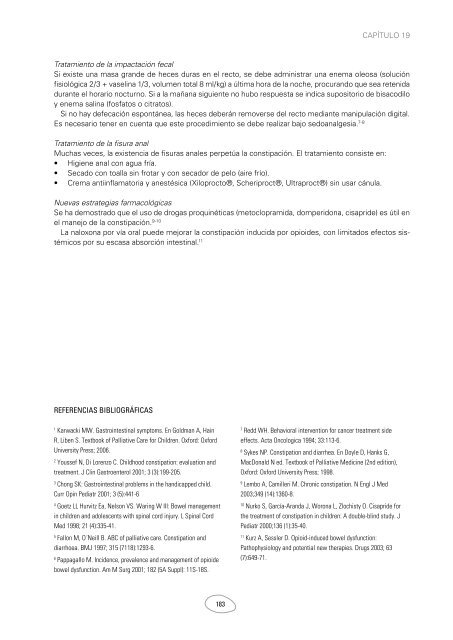Soporte_Pediatrico_para_el_paciente_Oncologico_Febrero_2013
Soporte_Pediatrico_para_el_paciente_Oncologico_Febrero_2013
Soporte_Pediatrico_para_el_paciente_Oncologico_Febrero_2013
You also want an ePaper? Increase the reach of your titles
YUMPU automatically turns print PDFs into web optimized ePapers that Google loves.
Capítulo 19<br />
Tratamiento de la impactación fecal<br />
Si existe una masa grande de heces duras en <strong>el</strong> recto, se debe administrar una enema oleosa (solución<br />
fisiológica 2/3 + vas<strong>el</strong>ina 1/3, volumen total 8 ml/kg) a última hora de la noche, procurando que sea retenida<br />
durante <strong>el</strong> horario nocturno. Si a la mañana siguiente no hubo respuesta se indica supositorio de bisacodilo<br />
y enema salina (fosfatos o citratos).<br />
Si no hay defecación espontánea, las heces deberán removerse d<strong>el</strong> recto mediante manipulación digital.<br />
Es necesario tener en cuenta que este procedimiento se debe realizar bajo sedoanalgesia. 7-8<br />
Tratamiento de la fisura anal<br />
Muchas veces, la existencia de fisuras anales perpetúa la constipación. El tratamiento consiste en:<br />
• Higiene anal con agua fría.<br />
• Secado con toalla sin frotar y con secador de p<strong>el</strong>o (aire frío).<br />
• Crema antiinflamatoria y anestésica (Xiloprocto®, Scheriproct®, Ultraproct®) sin usar cánula.<br />
Nuevas estrategias farmacológicas<br />
Se ha demostrado que <strong>el</strong> uso de drogas proquinéticas (metoclopramida, domperidona, cisapride) es útil en<br />
<strong>el</strong> manejo de la constipación. 9-10<br />
La naloxona por vía oral puede mejorar la constipación inducida por opioides, con limitados efectos sistémicos<br />
por su escasa absorción intestinal. 11<br />
REFERENCIAS BIBLIOGRÁFICAS<br />
1<br />
Karwacki MW. Gastrointestinal symptoms. En Goldman A, Hain<br />
R, Liben S. Textbook of Palliative Care for Children. Oxford: Oxford<br />
University Press; 2006.<br />
2<br />
Youssef N, Di Lorenzo C. Childhood constipation: evaluation and<br />
treatment. J Clin Gastroenterol 2001; 3 (3):199-205.<br />
3<br />
Chong SK: Gastrointestinal problems in the handicapped child.<br />
Curr Opin Pediatr 2001; 3 (5):441-6<br />
4<br />
Goetz LL Hurvitz Ea, N<strong>el</strong>son VS. Waring W III: Bow<strong>el</strong> management<br />
in children and adolescents with spinal cord injury. L Spinal Cord<br />
Med 1998; 21 (4):335-41.<br />
5<br />
Fallon M, O´Neill B. ABC of palliative care. Constipation and<br />
diarrhoea. BMJ 1997; 315 (7118):1293-6.<br />
6<br />
Pappagallo M. Incidence, prevalence and management of opioide<br />
7<br />
Redd WH. Behavioral intervention for cancer treatment side<br />
effects. Acta Oncologica 1994; 33:113-6.<br />
8<br />
Sykes NP. Constipation and diarrhea. En Doyle D, Hanks G,<br />
MacDonald N ed. Textbook of Palliative Medicine (2nd edition),<br />
Oxford: Oxford University Press; 1998.<br />
9<br />
Lembo A, Camilleri M. Chronic constipation. N Engl J Med<br />
2003;349 (14):1360-8.<br />
10<br />
Nurko S, García-Aranda J, Worona L, Zlochisty O. Cisapride for<br />
the treatment of constipation in children: A double-blind study. J<br />
Pediatr 2000;136 (1):35-40.<br />
11<br />
Kurz A, Sessler D. Opioid-induced bow<strong>el</strong> dysfunction:<br />
Pathophysiology and potential new therapies. Drugs 2003; 63<br />
(7):649-71.<br />
bow<strong>el</strong> dysfunction. Am M Surg 2001; 182 (5A Suppl): 11S-18S.<br />
183



![monografia+Acaros[1]](https://img.yumpu.com/32388786/1/190x135/monografia-acaros1.jpg?quality=85)